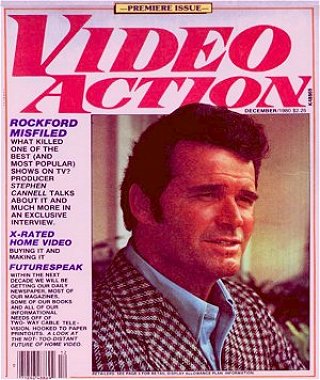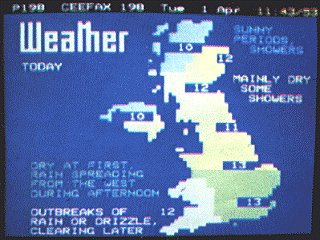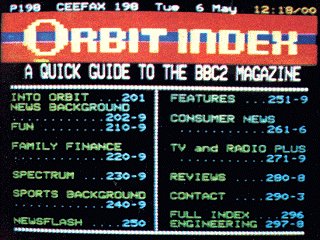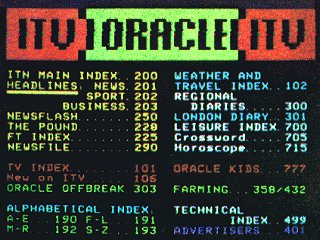 |
The Teletext Museum. |
|
|||||||||||
THE BRITISH TELETEXT REVOLUTION
| Meet the Jones family: Mr. & Mrs. Jones and their two children Susan, 16, and Bobby, 12. They are an average British middle-class family living in an average home with all the average modern conveniences, including a not so average television set.
Through their television, the Jones' lifestyle has changed by the simple fact that at the press of a button, they have access to a vast reservoir of news and information. They are a teletext family enjoying a brand new form of journalism without deadlines or bulletins. Teletext is news and information available instantly. It is morning in the Jones household. Mr. Jones is first to rise. He turns on the TV set and, using the remote control keypad, quickly punches in the number that call up the 'pages' featuring the news headlines and latest weather forecasts. While breakfasting he scans the pages of stock market reports and exchange rates. He has an important business meeting in Manchester. A quick check of the motoring conditions section tells him that road repairs will make the journey by car impractical, so he selects a suitable train from railway timetables called up by keypad on another video 'page' . With her husband off to work, Mrs. Jones uses the television set to plan her shopping trip to London that day. However, before using the keypad to call up the pages of the consumer guide section, she cannot resist a quick look at the pages which display the synopsis for her favourite soap opera, of which she missed yesterday's episode. Having done that, she checked prices at the stores she intends to visit in London and looked at that day's diary of events in the capital city, she like her husband, calls up the rail travel section to find a train that will get her to London before lunch. Their parents out of the way, the next Jones children take over the teletext system. Like many other such households, they are the family members who most quickly adapted to the new medium and virtually control its use during the times when the whole family is together. Today Susan is eager to find out the latest happenings in the pop music charts and also uses her keypad to call up film reviews and the latest fashion news. Bobby, the energetic 12 year old, like many kids, learned very quickly how to key in the numbers that called up his favourite pages. Not only does he want to see how his football team faired last night, but he knows that the special puzzle and jokes pages are due to be updated today - and that can not be missed! The above scenario easily could be read as yet another of those 'gee whiz' predictions of what the future has in store for mankind, except for one small detail: all of it is happening in Great Britain now, in 1980. Currently, 100,000 specially adapted sets have been sold or rented to very ordinary people like the Jones family. To enable these sets to exist at all, three complete textual information systems are in full time operation. It is even claimed that the potential audience for these systems is greater than that for normal television broadcast because teletext sets are displayed in public places like hotels, libraries, and police stations. Two of the systems have been developed by Britain's two network television companies, BBC and ITV, and are broadcast by them simultaneously with the regular TV signal. The third, Prestel, is more of a newcomer, having been developed and now controlled by the British Post Office. For this a specially adapted TV set is hooked into the existing telephone system (also run by the Post Office), along which Prestel's computer generated information is transmitted, allowing for a much greater flexibility of operation. The entire Prestel system will be the subject of a separate article in the next issue of Video Action. This time the spotlight falls on the two broadcast teletext systems - Ceefax and Oracle. In 1972, research engineers of the government owned BBC put together a number of new technological developments and found a way of making better use of the ordinary television signal. They found that the British standard 625 line TV picture has several 'spare' lines, not used to form the screen image. Digital pulses, travelling as part of the regular TV signal, could with the aid of a decoder built into the domestic receiver, be formed into numbered panels of textual information called 'pages.' These pages look rather like pages of typescript, except that they can also include large-size letters and simple drawings; maps, graphs, diagrams, and so on, in any of six colours. Each page can carry as many as 200 words. A hand-held remote control unit could be used to select individual pages by tapping in the number of the page required. They called this system Ceefax. The BBC was not alone in its discovery. The IBA, controllers of Britain's commercial radio and TV stations, were also developing a teletext system. They called their system Oracle: Optional Reception of Announcements by Coded Line Electronics. Within six months the BBC had begun test transmissions of Ceefax. In 1974 all the organizations with an interest in the new information systems came together with the object of devising a unified standard. In September of that year a trial experiment began for both systems culminating in the Autumn of 1976, with the government giving the green light to start full transmissions of both Ceefax and Oracle. To receive the teletext systems, television sets had to be equipped with decoders; paperback size packages of electronics that could be built into new sets and added to existing ones as external adapters. Either way it added considerably to the cost of a domestic television set; $450 extra at present, though it is hoped prices will tumble as more and more people become aware of the systems. However, once equipped with a teletext-receiving set, a viewer has a wealth of information literally at his or her fingertips: news (updated constantly), sports, business, road, rail, sea and air information, film theatre, ballet, music news and reviews, exhibitions and events nationally, TV listings, book news and reviews and much, much more. With Ceefax the BBC enjoys an advantage over its IBA rival in that it has two networked channels through which to run its teletext system. This is only a temporary advantage, however, as the IBA is to open its second TV channel in a little over a year. On a typical day, over 400 pages are shared between the two BBC TV channels, BBC-1, the main channel, carries the 'instant' news-oriented pages which need constant updating: news, sports, finance, weather, travel; while BBC-2 groups its pages into an electronic 'magazine' called Orbit, which caters to the leisure minded. Consumer news and advice, music, theatre and films and a special children's section are just some of its contents. The pages are transmitted on a continuous cycle - roughly 100 pages every 25 seconds. The page selected by the viewer is held or 'frozen' on the screen whilst the cycle continues automatically. If the number of the pages required is keyed in before that page comes round on the cycle, that page appears almost instantaneously. However, should the page have been transmitted it is possible to wait up to 25 seconds before it appears on the screen. A team of 20 people operating from a relatively small office atop BBC TV's London headquarters compile Ceefax's information and constantly keep it up to date during its broadcast hours from 6:00 AM to midnight, seven days a week. The service costs the BBC about one million dollars each year to run, a sum a Ceefax spokesman described as '...a drop in the ocean' when compared to how much the Corporation spends on its other broadcasting services. The Ceefax editorial office is fed by all the major international news agency wire services as well as being linked to BBC-TV's own extensive news department. Fast breaking news stories literally can be updated by the second. For those that need to be kept in constant touch with an important story, there is a page facility known as Newsflash. Once activated by a button on the keypad, the latest details of that story will appear, automatically, in a small box cut into the normal TV picture. This facility recently has been developed to provide subtitles for the deaf or hard of hearing to some of the BBC's top rated variety and drama shows. The view calls up the relevant page and Ceefax cuts in the subtitles automatically as the show is broadcast. However, this sort of application is still being evaluated and is only a small part of Ceefax's main function as an information provider. The commercially based Oracle encountered an entirely different set of problems. 'In a sense it's a miracle that Oracle ever got on the air at all,' said a spokesman for the company. 'After all, we are the logical thing to turn to when the commercial breaks come on!' This remark highlights the major differences between the Ceefax and Oracle operations. Ceefax is funded by taxpayers' money, while Oracle is supported by revenue from advertising on commercial television. Oracle is jointly owned by the 15 regional television companies that make up Britain's Independent Television (ITV) network. Each finances the system proportionately to its wealth. Based at the main studios of one of the two London commercial stations, Oracle currently broadcasts around 350 pages of information 15 hours a day, seven days a week. Having only one channel on which to run the system, Oracle is reluctant to expand the system any further because of the wait time for pages - around 1 minute presently. Each new page adds one quarter of a second to that time. All news and finance pages are produced from a sub-office at ITN, another jointly owned ITV company, providing news for the whole network. Here, a small team has its own block of pages which it prepares and feeds straight into the system each day. This leaves the main Oracle editorial office to produce the information and service pages. With 15 ITV regions to serve, Oracle naturally has to devote a lot of space to television listings for each company and prides itself in having full reviews of every film being shown within the ITV network each day - no mean feat! Another major task is a 'What's On' section for the whole country. Major cities are adequately served with publications listing theatre, opera, ballet, music, films, and festivals in their own areas, but nowhere has there been an effort to combine all this information on a national scale, except for teletext. All in all, Oracle provides basically the same sort of information service as Ceefax, though perhaps with more of a popular style. They tend to design flashier graphics (a great field of rivalry between the two companies) and were the first to develop a special TV camera that can scan photographs and convert them to teletext pages. Although still and experiment at the moment, advertising is carried in a very limited form in the Oracle system and is certain to play a major role in the system's future. 'It will have to if we are to survive.' said a spokesman. Being such a new and unknown medium, attracting the attention of the big ad agencies is still a difficult job. However, competitions run on the system by the set manufacturers have proved to be enormously successful and are sure to help prove Oracle's case. All of this activity is merely the top of tip of the iceberg. Though primarily developed for the consumer market, the uses of teletext systems in industry and education are manifold. For industry and commerce, Ceefax and Oracle already offer regular market reports throughout the day, plus major company news, news of exchange rates, reports from industry, and international financial news. Ceefax operates a special newsroom for its financial service, attached to the BBC's own financial unit. From there 3 journalists provide hourly updates of selected shares, the Financial Times Index and a myriad of other services including reports from Wall Street and many other world money markets. In education, experiments are being conducted to find out exactly what kind of service is best suited to Britain's schools and colleges. So far, Ceefax and Oracle have joined forces on two major experiments involving selected schools and colleges throughout the country, providing back-up material to regular educational television programs. The advantage of the teletext system is that the pages of material are available to the students and teachers to refer to at their own speed before and after a program is broadcast. Oracle reports some schools have used information on their system to trace weather patterns over Europe. An unexpected bonus has been the interest shown in school-children in designing their own graphics for teletext pages. Oracle has a constant demand for grids to be supplied to schools to cater to this new art form. With an electronic medium such as this still so much in its infancy, the future can only be bright and full of fascinating developments. Undoubtedly, the major goal all concerned with the teletext industry are seeking to achieve as quickly as possible is greater public awareness. Despite the existence of both Ceefax and Oracle for nearly three years now, large sections of the consumer market are unaware of the new medium. Much of this is due to the big TV rental companies (through which 60% of TV sets in the UK are placed) being slow to realize the potential of teletext. This, however is at last changing. Only with the mass market being reached will the cost of teletext receivers come down. Ceefax estimates that by 1985, or sooner, the decoder units will become cheap enough to be installed in all new colour television sets coming off the production line. They also foresee a new generation of decoders fitted with microprocessors enabling viewers to feed information into their TV sets as well as take it out, thereby creating the 'intelligent' television that can work out their tax problems, teach, and play games. Both Oracle and Ceefax have plans already drawn up for full regional services. Local news and information then will be available at the push of a button. Viewers will be able to check prices at their local supermarket before leaving home. So everything in the garden looks rosy for Britain's two teletext systems -- or does it? On the horizon stands the mighty Prestel, the latest contender in the battle for control of your home TV. It casts an awesome shadow over Ceefax and Oracle; over a quarter of a million pages currently available; a capacity for more without the headache of extending wait time; input and output facilities; the backing of the Post Office and page space available to anybody who wants to buy. |
The British Teletext Revolution So wrote Richard
Burton in the first |

|
|
|
These are the images
which were published |
|
|
...it added considerably |
|
 |
|
 A rarely seen example of the BBC2 index page during the services short-lived incarnartion as ORBIT |
|
| The commercially based Oracle encountered an entirely different set of problems. 'In a sense it's a miracle |
|
 |
|
| With an electronic medium such as this still so much in its infancy, the future can only be bright and full of fascinating developments. |
|
 |
|
 |
Teletext Timeline | Teletext links
|
|||
|